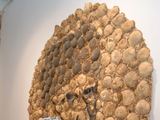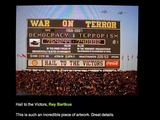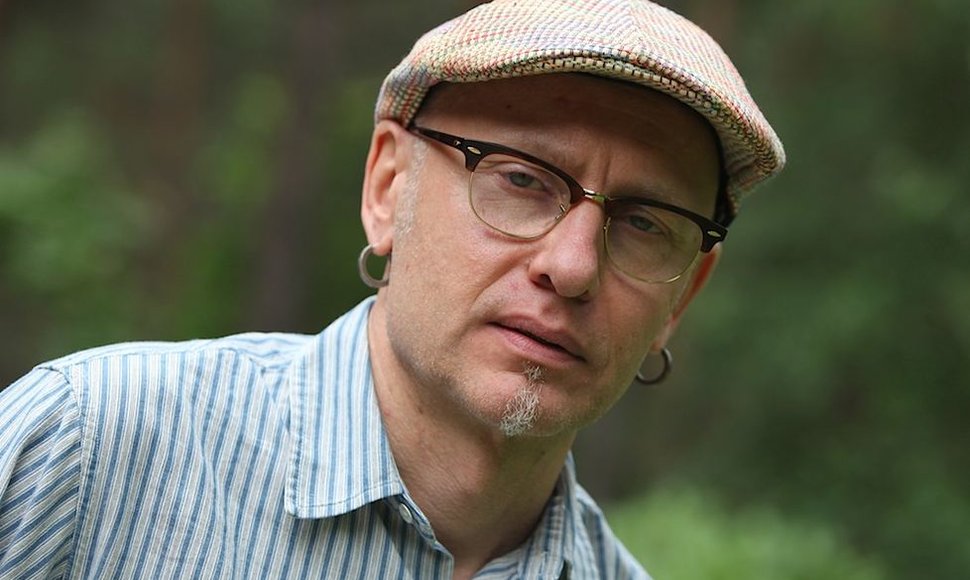In mid-summer, Bartkus came to Lithuania for three weeks – not just to visit his relatives, but also to take part in World Lithuanian Youth meeting and make arrangements for his personal exhibition scheduled for autumn.
- I am a Vilnian living in New York, – he introduces himself. – I was born and was educated in Lithuania, I will always remain a Lithuanian. But I've been living there for 22 years already, so I have been influenced by New York. My son, who left when he was five, considers himself an American, even though he does speak Lithuanian.
In Lithuania and some other places, I am Rimvydas. Friends call me that. I am Rimvydas even in New York, if I'm talking in Lithuanian. If in English, I turn into Ray.
- According to Google, you are the only Ray Bartkus in the entire USA. Could you have become so exceptional – and I do not only mean your name but also your career – had you stayed in Lithuania?
- One of the reasons that I left for was the fact that Lithuania is such a small country. Sure, the world is opening up now, artists travel, they go to creative workshops, take part in international shows. But there's not much competition in Lithuania, or it goes on among Lithuanian artists.
 |
| Asmeninio albumo nuotr./A piece by Ray Bartkaus |
In New York, you compete with artists of the entire world. This moulds you into a completely different person. You compete with ideas that fly around in New York but that come from France, Australia, China. Just like water polishes a tree thrown into the sea, sculpts it into something new, so all the currents there help you discover yourself. If you're lucky, you become much more real.
Lithuania had already declared independence, but I left still bearing a Soviet passport. You wouldn't be allowed to travel before, so I'd always felt trapped. As soon as there was a possibility to leave, I took the chance to try and live somewhere else.
- How have you managed to not get lost in the crowds of New York? Many emigrants start sporting heavy accents after only several years.
- I think they are play-acting. My wife and son are Lithuanian, so we speak Lithuanian at home.
If we left for another city in the US, there might be a stronger pressure to turn American. Not in New York. People born in the US make up probably one fourth of its residents. You might just as easily turn Mexican, if you live in their neighbourhood. But neither community tries to impose their will upon you. If you lived in Kentucky or Alabama, where the population is 90 percent American, you'd experience greater influence. But not in New York.
When I came and was looking for job, speaking with a heavy accent, no one asked me once: where are you from, what are you? Everyone saw I was a newcomer, probably from Europe. But only 5 or 6 years later, after becoming more close, would people ask where I was from. Strange, since I had a little story prepared: “Ah, I come from Vilnius...”
- You knocked on many newsroom doors, but the only one that was opened to you was to the New York Times itself...
- I had to crack the American psychology. I would show them my works and they, unlike Lithuanians (those would be blunt: total crap), would always reply very politely: how great, we will surely give you work! I would go home and wait for a phone call. But none would come. I realized it was customary to be polite, to avoid direct replies that your services are not required.
A similar thing happened at the New York Times: pretty! I didn't expect to receive a phone call, but I did.
Before that, I had walked through many galleries and art editors. Those same people, after seeing my name in the New York Times, started calling me. I didn't remind them they had passed me over once – that would have been impolite.
I later discovered that an art director receives 50 to 70 portfolios a day. Certainly, no one looks at them, that would be impossible, unless someone else makes a call. In the end, it is difficult to decide: a portfolio looks good, but that's not enough to know if the person can work in the press where you need quick results. A person might come up with a masterly work but that takes him or her two weeks.
- How much time do you have for such works?
- Depends on the publication: if it's a weekly, a bi-weekly, a monthly, if it reports on current affairs or culture. In dailies, it happens that I get the written piece at two and I have to be done by five. You must present six or seven different sketches. Editors then confer and decide on which way to go. I spend one hour on sketches and two hours to finish the final work.
- Unlike before, work finds you nowadays?
- It took 2 or 3 years before I had enough work to make a living. If you only have one client, that is not enough to support yourself.
- What storied do you tell through your illustrations? Do you stick to the text you're given or do you add something extra, so that the drawing is an author's piece worthy of being displayed in a gallery?
- A 3 or 5-page text conveys many ideas and views. It is important to catch the essence. Verbally, you can convey one message, then another, while an image comes all in one go. I try to create an image that contains many meanings – a truth is not necessarily black or white – that does more than echoes the text.
85 percent of my images are based on my own ideas, but sometimes editors suggest something. Recently, I had a commission from the Wall Street Journal. They even sent me a sketch. I like it, less work for me (laughs).
Of course, it wasn't interesting, I didn't even want to take it up, but I was already in Lithuania and they were helpful enough to specify what exactly they wanted. The story was on economic issues between Europe and the US. I had to draw a shield, representing America, withstanding arrows coming from Europe. A rather flat idea – right, but straightforward and not very exciting. Art editors often have superiors without much visual thinking.
- You've also developed a fake news website thisisreallybadnews.com where you display fakes as art. Why this attraction to simulation, to contrived reality?
 |
| onegodonemaster.com nuotr/Ray Bartkaus piece |
- I started to work before the age of computers, when illustrations were done by hand and using real things – like collages. When I switched to digital, I saw how easy it was to manufacture reality.
I prefer the realist approach. When I started working with photography, Photoshop, I was very interested in this possibility to create non-existent but real-looking objects. There have been cases of people calling the newsroom to inquire if they really exist. I had to let them down – no, it's just my vision.
- You often scoff at the consumerist culture in your works, even though you choose to live in the US, the heaven of consumption.
- It's the same in Lithuania – go to [shopping malls like] “Akropolis” or “Ozas” and you'll see a perfect consumerist culture. It's up to every person what and how they consume. People certainly consume more than they need. That's how money is made. Using a thing for several days and throwing it away – that's a crime.
- Is it difficult to make modern art? You can get away with taking a painting, incorporating it into an installation and voilà, a piece. It doesn't sound like it involves much craftsmanship, just an idea.
- It's an outcome of a long development that now everything is art. You must look at your life as art. You are writing – that's also art. It depends on how you look at it – like it's work, duty, or creativity. Talking to your friends is also art.
Marcel Duchamp proclaimed all life to be art. But then another question arises – what is this thing art? Is there any sense in drawing or doing something?
I make a lot of art where I don't have to do anything myself. I hire people to help me. But I miss the touch of my own hand, pieces where you could see brushstrokes on a canvas.
All genres and techniques coexist simultaneously and each finds its proper audience. In New York, with its 12-million population, followers of one trend in art sometimes have no clue what's happening in another. A narrow section can have enough artists and admirers to maintain and buy that art.
- In Kiev, you presented a portrait of Vincent van Gogh composed of sunflowers and the Ukrainian press dubbed you the prophet of Western art. How do you react to such titles? Are they not heavily obliging to exceed yourself?
- That's their problem. I didn't call myself that, but if they found me prophet-like, well, it's interesting. That show was the first one in Kiev, very big and diverse, it sent a lot of ripples. It was very interesting for me, there's a lot of immediacy in the Ukrainian public.
- You left Lithuania together with your wife, Ina. How have you managed to keep your relationship alive? Was it easier having her at your side? Perhaps hard times helped stay together?
 |
| Asmeninio albumo nuotr./Ray Bartkus and his wife Ina |
- I would agree. Fighting for your place in the sun is easier in twos. We are a team. Over the twenty years, there have been periods of one of us making more money and helping the other and the other way round. It makes sense financially but also psychologically – if we are a cell, support each other, it hardens and bonds us.
- How often do you come to Lithuania?
- My father and my parents-in-law live here. I come once a year, since I've got art projects and other tasks to attend to.
Living in New York and reading the Lithuanian press gives you a much worse impression about what's happening in Lithuania. Sometimes I wonder – why am I going there? But then I do go and see that everything is much better and more pleasant.
- In World Lithuanian Youth conference you bring a provocative installation – a new name for Lithuania (:EthUWA! What's the use of a new name?
- Lithuanians from all over the world are coming to Lithuania. The challenge for the country is to use the potential of all these foreign-educated youths. Different characters stand for experiences gained abroad. I replaced Lithuanian characters with those of other languages, but the meaning remained the same.
- You were planning to go and spend some time in Mexico or Vietnam. Have you carried out this plan?
- I'm not making any promises any more (laughs). I could live and work anywhere, as long as there's an internet connection. I'd love to leave for at least a year, it would make for an exciting experience, but my wife is attached to the place – she has a new job, her career is going well, it wouldn't make sense to drop everything and leave.
Could I survive in Mexico or Vietnam for over half a year? Perhaps I'd miss the comforts of New York? I'd love to try it, I hope I will.
- You seem to have achieved everything a person can dream of: happy family life, home in New York, fame in your own country and abroad. What other dreams do you have?
- I always dream. For instance, to create a good piece. I've done a lot of works in different styles and techniques. Now I want to bring all different knowledge together and do something simple. I'm planning to go to Korea. I'll climb a mountain, meditate, and think what to do next.
Ray Bartkus
Rimvydas (Ray) Bartkus was born in 1961 in Vilnius. He graduated from Vilnius Art Institute in 1986 and created lithography, etchings, drawings, participating in exhibitions in Lithuania and abroad. Upon being offered to present his works in a US university, he decided to move to America. In 1991, Barktus, his wife Ina, and their son Kristijonas settled in New York.
His pieces first caught the eye of the New York Times' art director. Bartkus' works have since been used on covers of Time magazine, Newsweek, Harper's, the New York Book Review; they have been published in the Wall Street Journal, the Los Angeles Times, the Boston Globe, Business Weekly, Fortune, Smart Money, the New Republic, the Christian Science Monitor.
He took part part in exhibitions in New York, Helsinki, Hague, Vienna, Skopje, Warsaw, Beijing, Vilnius, Kiev.
His oeuvre includes portraits of Immanuel Kant, Socrates, and Giordano Bruno carved in bread; copies of his three passports, Soviet, Lithuanian, and American; counterfeit one US dollar bill and one million dollar cheque.
One of his works can be seen every day – Bartkus is author of the 50 litas bill, the one with a portrait of Jonas Basanavičius.













